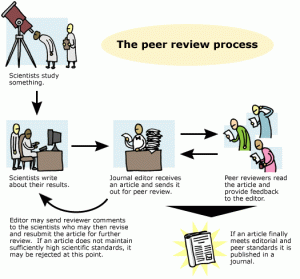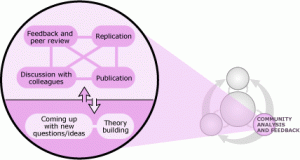3 Information Communication
Andrea Bierema and Sara Miller
Learning Objectives
- Recognize that a given scholarly work may not represent the only, or even the majority, perspective on the issue.
- Recognize that information may be perceived differently based on the format in which it is packaged.
- Recognize issues of access or lack of access to scientific information sources.
- Recognize that one’s personal information and online interactions affect the information one receives and the information one produces or disseminates online.
- Evaluate an information source.
Community Analysis and Feedback
One of the main elements of the science flowchart is “community analysis and feedback.” Members of the scientific community play several essential and direct roles:

Learn more about the peer review process of scientific articles!
The scientific community provides a system of checks and balances that ensures the quality of scientific work, double-checks arguments, and makes sure that ideas are evaluated fairly. This scrutiny can serve a few different functions from fact-checking to whistleblowing.
The community evaluates evidence and ideas. Scientists describe their work at conferences, in journal articles, and in books. By disseminating their ideas, study methods, and test results in these ways, scientists allow other community members to check their work, both by reviewing what has been done and trying to replicate all or part of it. This helps to ensure that evidence meets high standards, that all relevant lines of evidence are explored, that judgments are not based on flawed reasoning, and hence, that science moves in the direction of more and more accurate explanations. For example, in 1989, when two scientists claimed to have produced nuclear fusion at temperatures lower than was thought possible, the scientific community took a close look at their methods and results. Community members found several ways to improve the experiments and several tests that the original researchers had failed to perform. Meanwhile, other scientists got started on trying to replicate the experimental results and discovered that they could not be consistently reproduced. The scientific community ultimately found that the evidence was not compelling enough to warrant accepting the researchers’ claims.
Scientists are people, too. They come from different backgrounds, have different personal beliefs, and favor different hypotheses and theories which can result in unintentional biases even when scientists strive to remain objective. Luckily, the scientific community is diverse, and for every scientist who looks at a result through rose-tinted glasses, there is another who peers at it through her own blue-tinted ones. Because of the community’s diversity, individual biases are balanced out and the community as a whole can evaluate scientific ideas fairly.
The community helps identify and eliminate fraud. Though fraud is rare in science, it sometimes happens. These occasional cases of fraud are identified through the scrutiny of the scientific community. For example, a recent case in which medical researcher Jon Sudbø faked data on 900 Norwegian patients was discovered by another scientist familiar with the group of patients with whom he claimed to be working. Because they build upon the work of others, scientists take fraud very seriously. No one wants to build their own work on a shaky foundation supported by fraudulent ideas.
Science depends on its community in many ways: from the specific (e.g., catching a mistake in an article) to the general (e.g., dividing up the enormous amount of work that keeps science moving forward). Being part of that community means meeting some expectations.
Article Types
Scientists distribute information about their ideas in many ways (informally communicating with colleagues, making presentations at conferences, writing books, etc.), but among these different modes of communication, peer-reviewed journal articles are especially important.
A journal article is a formal, souped-up version of the standard high school lab report. In journal articles, scientists (usually a group of collaborators) describe a study and report any details one might need to evaluate that study: background information, data, statistical results, graphs, maps, explanations of how the study was performed and how the researchers drew their conclusions, etc. These articles are published in scientific journals, either in print or on the internet. Print journals look much like any magazine, except that they are chock full of firsthand reports of scientific research. Journals distribute scientific information to researchers all around the world so that they can keep current in their fields and evaluate the work of their peers. Journal articles neaten up the messy process of science by presenting ideas, evidence, and reasoning in a way that’s easy to understand—in contrast to the often circuitous (and sometimes tedious) process of science. Check out the article below to learn more about the different ways in which scientific research is published.
Headlines
- Trans-fat free!
- Ethanol production: an eco-nightmare?
- Cancer researchers discover new hope.
- Major petroleum company acknowledges the reality of global warming.
- Clinically proven to reduce the appearance of wrinkles!
The above statements aren’t exactly the headlines you’d find in a scientific journal, but they are examples of the sorts of scientific messages that one might encounter every day. Because science is so critical to our lives, we are regularly targeted by media messages about science in the form of advertising or reporting from newspapers, magazines, the internet, TV, or radio. Similarly, our everyday lives are affected by all sorts of science-related policies from what additives are allowed (or required) to be mixed in with gasoline, to where homes can be built, to how milk is processed, but you don’t have to take these media messages and science policies at face value. Understanding the nature of science can help you uncover the real meaning of media messages about science and evaluate the science behind policies.
Exercise
Let’s practice!
Source Evaluation
Every day, we are bombarded with messages based on science: the nightly news reports on the health effects of cholesterol in eggs, a shampoo advertisement claims that it has been scientifically proven to strengthen hair, or the newspaper reports on the senate’s vote to restrict carbon dioxide emissions based on their impact on global warming. Media representations of science and science-related policy are essential for quickly communicating scientific messages to the broad public. However, some important parts of the scientific message can easily get lost or garbled in translation. Understanding the nature of science can make you a better-informed consumer of those messages and policies. It can help you:
- separate science from spin
- identify misrepresentations of science, and
- find trustworthy sources for further information.
Moreover, an original piece of scientific research may be interpreted many times over before it reaches you. First, the researchers will write up the research for a scientific journal article, which may then be adapted into a simplified press release, which will be read by reporters and translated yet again into a newspaper, magazine, or internet article and so on. Just as in a game of telephone, errors and exaggerations can sneak in with each adaptation.
Exercise
Before getting into the details on how to analyze information sources, let’s consider the following hypothetical article. What are some things to consider while evaluating this article? In the image, click on the exclamation point icons to learn about some concerns regarding this article.
Attribution
This chapter is a modified derivative of the following article:
Understanding Science. 2020. University of California Museum of Paleontology. 11 June 2020 <http://www.understandingscience.org>.


